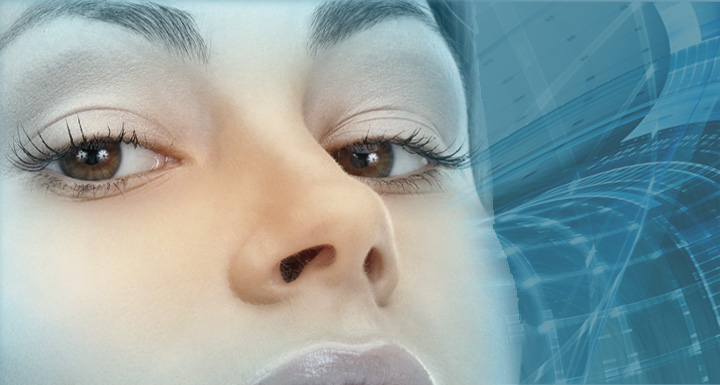Revision or secondary rhinoplasty corrects deformities caused by a previous operation on the nose.
The failure of rhinoplasty can mean bad result in the appearance and ⁄ or function. In such a case it may require the patient to undergo a secondary rhinoplasty (Revision Rhinoplasty).
When the aesthetic result is far from what was originally designed, then the operation is unsuccessful.
We consider also as failed the operation that harms the natural mobility of the face which is distinctive caracteristic of humans especially in their social life, such as laughter, frustration, weeping or smiling.
Sometimes it is so obvious that a surgery preceded in the area that it has to be corrected.
Also, clearly it should be noted that if after rhinoplasty, respiratory function is not normal, the revision is considered necessary and the initial surgery as particularly failed.
The operation
The general objectives of revision are the same as the initial operation but many times there are restrictions due to heavy burden from the first surgery. So while the discussion between surgeon and patient is obvious that plays a very important role in every rhinoplasty, in case ofrevision this role is even more important, because there are chances that the outcome desired by the patient is no longer possible due to the new situation in which the nasal backbone is.
The surgeon of the secondary rhinoplasty, unfortunately, sometimes regrets to set the bar lower and should clearly inform the patient about it.
Wanting to give an overview of the possible problems and possible interventions we will distinguish some categories:
- Removal of a smaller part of cartilage or bone in the first surgery, so usually we proceed to additional removal.
- Move cutting in the wrong place so usually repositioning or placement back into the correct position may solve the problem.
- Removal of a larger part of bone or cartilage, therefore required movement of the parts that are left in a new position, with fixation and support to cover the deficit or use of cuttings for the same reason.
- About the cuttings generally used in rhinoplasties, just to mention that we usually prefer to get them from the area of the nasal septum, if possible. Unfortunately in revisions many times is necessary to take the cuttings from the ear cartilage or cartilage from the sides, because the nasal septum is distorted, deformed or removed from the first surgery.
Stages
At rhinoplasty revision we can have from very few up too many stages, for this reason the duration can vary so much.
Below we relate many different possible stages. Each patient is unique and the appropriate combinations are selected depending the case
- Small incisions in both nostrils (not visible after the surgery) and in case of “open” rhinoplasty joining of incisions together at the bottom part of the nose
- Removing the nasal bone
- Straightening the nose (bone and / or cartilage part)
- Elevation of the bottom of the nose,tip of the nose (in “Fallen” nose)
- Forming the lower part ,that may include thinning, elevation, reinforcement etc.
- Reduction of all dimensions of the nose (in a “big” nose)
- Increase all dimensions of the nose (in a “small” nose) using cuttings
- Strengthening the lower part of the nose, where during vigorous inhalation we have the phenomenon of collapse
- Increasing the angle of the nose (as seen below) in case we have a very narrow nose (narrow inner valve) and nasal breathing difficulty
- Taking cuttings from the following areas in order of preference: nasal septum, other areas of the nose, ear, thoracic side
- Removing Scola (skewed) nasal septum or move it to the midline if necessary
- Reducing the size of the nostrils
- Suturing the incisions with absorbable sutures (in open rhinoplasty three tiny stitches are placed at the base of the nose)
- Placing soft capping inside the nose for one day
- Placing small splint on the dorsum of the nose for one week
Anesthesia
Usually general and in some cases local anesthesia
Duration of surgery
The duration of the operation depends on the kind of problem. It can range from 45 minutes to more than three hours in cases where many cuttings are taken from other areas.
Stay in the clinic
Discharge 6 hours after surgery. In combination with other operations such as Uvulo-Palato-Faryngoplasty the patient leaves the clinic next morning.
Result
Permanent
Combination with other operations
If there are functional problems of difficulty in nasal breathing can be combined with straightening of the nasal septum and cauterization of concha and in this case we are talking about a functional revision rhinoplasty.
For treatment of sleep apnea and snoring can be combined with adenoidectomy, tonsillectomy, Uvulo-Palato-Faryngoplasty or excision of the uvula.
Instructions after surgery
- Immediate mobilization of the patient after surgery
- Removal of the light capping the day after
- Special care for the internal of the nose by washing (with natural serum) and placement of ointments, 3 times a day for about a month.
- Removal of slight internal packing of the nose (slight internal splint) a week after the operation, while in case there isn’t any splint placed, we place some special stickers-steristrip- on the back of the nose which we remove usually in 5-7 days
- No painkillers required
- Antibiotics only given as a precaution for 4 days
- There is no sutures removal because they are internal and are being absorbed/rejected,while in the case of an open access three very fine sutures are removed simultaneously with the removal of the splint or steristrips.
- Edema-swelling-and any bruising in the nose area is usually very small, and over a period of about two weeks they have subsided almost completely and the 80% of the result is evident.
- In cases of small revisions there is basically almost no postoperative oedema and the final result is evident only 10-20 days after the operation.
- In cases of big revisions a period of approximately three months is needed in order to reach almost all of the result while the strengthening of the nasal skeleton and the full results are shown in about a year.





 Press here to download a free QR Reader
Press here to download a free QR Reader



